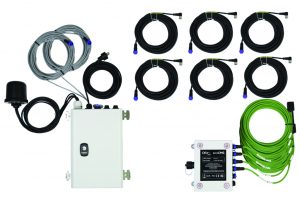ANSI, the American National Standards Institute, recently approved the publication of a new standard addressing the need for dropped object prevention and tool tethering. It was approved July 2 and formally known as ANSI/ISEA 121-2018, American National Standard for Dropped Object Prevention Solutions.
This standard addresses the real need for reducing workplace accidents, injuries and deaths due to falling objects.
Dropped or falling objects from height present a significant safety hazard in many industries around the world today and the numbers are staggering. According to the Bureau of Labor Statistics, more than 52,000 “struck by falling object” OSHA recordable incidents occur every year in the U.S. alone. In 2015, the BLS reports 247 fatalities from being struck by a falling object, accounting for 5 percent of all workplace fatalities.
Most contractors rely on catching the falling object (netting, toe boards, etc.) or erect temporary structures to shield people on the ground in the event of the inevitable drop. While this does help reduce the number of actual injuries caused by falling objects, it doesn’t address the real root cause, and so the risk of injury or worse is always present. The only way to reduce the chance of injury or harm to zero percent is to prevent the uncontrolled fall in the first place.
Objects dropped from height strike the ground with incredible force. Take a simple tape measure weighing in at just 0.5 pounds. If it was dropped from a height of 10 feet, someone wearing PPE struck by it below will most likely only suffer a slight injury treatable with just first aid. Drop that same tape measure off the 17th floor of a building, and it will carry enough energy to defeat any PPE and even cause a fatality. A 2-pound wrench can be deadly from the fourth floor, and a standard power tool such as a drill can be serious from lower still.
The new standard is ground breaking, requiring dropped object prevention solutions to undergo dynamic drop testing to be considered fit for use.
When the ISEA 121 committee on Dropped Object Prevention (DOP) began working on the new standard, they made a keystone decision to require dynamic drop testing to prove all DOP solutions instead of the traditional static testing. But why is this important? How does this make us safer, and what is dynamic drop testing anyway?
Up until then, Dropped Object Prevention companies have tested their products the same way rock climbing companies test their rope and carabiners. They used a math equation and a static tensile test. To follow this method, you take the mass you’re going to drop, use physics to determine the velocity it will be traveling at the full extension of the tether (aka lanyard) and, from that, determine the impact force that object will have when it is suddenly stopped by either the tether or the ground (hopefully the ground and not a person below). This force is many magnitudes higher than just the simple mass of whatever was dropped. A 10-pound weight dropped 120 inches has an impact force of 460 pounds. To test the DOP device, a lab attaches it on a static (not moving) tensile testing rig and pulls or stretches it from both sides. The lab increases the force on the device until it breaks. If it breaks with a force higher than the minimum impact force, then it passes and is deemed safe for use. If it breaks at a force lower than the impact force, it’s back to the drawing board or to a lower weight rating.
There is one problem with static testing. Static testing is an excellent way to determine how much force a safety device can withstand before it breaks (called load capacity) when it is pulled straight down and everything is perfectly aligned. However, in real life, dropped objects rarely fall straight down. They tend to swing, ricochet off structures and scaffolding, bounce and recoil in unpredictable ways.
A device may pass a static test with flying colors, but when put into a real-life situation, when the straps or cable, d-rings, carabiners, and other part are stressed and strained in ways that are not perfectly aligned by gravity, motion, and dynamic force it may still fail and break and that’s bad for anyone standing underneath. This is something no contractor, worker, or manufacturer wants to discover on the jobsite where lives are at stake.
With a dynamic drop test, an object of known weight is dropped multiple times. If the device prevents a drop, it passes. If it breaks and the object drops, it fails. The device is still subjected to the same impact force as it would be in a static test, but with the added challenge of proving the total solution can withstand the stress and strain of swings, bounces, and recoils real devices are subject to everyday. When (not if) things don’t perfectly align during the test, the device must still fight off gravity and prevent a drop, and that is something you just can’t simulate with a static test.
MORE INFO: www.dropsafetyequipment.com








































